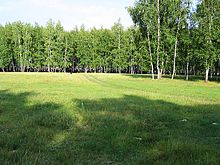Ivanovka (Omsk)
| Village
Iwanowka
Ивановка
|
||||||||||||||||||||||||||||||
|
||||||||||||||||||||||||||||||
|
||||||||||||||||||||||||||||||
Ivanovka ( Russian Ивановка ) is a small, predominantly German-speaking ( Plautdietsches ) village in the western part of Siberia , which is located in the Issilkul district of Omsk Oblast about 120 kilometers west of the city of Omsk .
It belongs to the rural community Kucharewskoje selskoje posselenije , whose administrative seat is in the village of Margenau, about two kilometers to the northwest .
history
The village of Ivanovka was founded by German immigrants in the spring of 1907, two kilometers south of the Kucharewo station of the Trans-Siberian Railway (route km 2784 from Moscow ), on land bought by the Cossack officer Ivanov, to which the village name Ivanovka refers.
In the eastern part of the country there was a small lake and adjoining pastureland for the cattle, in the southwest there was a forest (see village map 1928). Originally, individual farms were built about one kilometer from the forest, from which a small settlement emerged, which was named after the name of the then landowner Epp Epp-Chutor . Later a settlement was also created on the edge of the forest. Over the years, these settlements grew together to form a village officially named after the Cossack officer Ivanov Ivanovka in 1917 . In October 1929, several villagers sold their houses and made their way via Germany to Canada and Paraguay . Several new families moved into the village.
In the 1970s it was said that Ivanovka was a "village without prospects"; it was supposed to disappear as quickly as possible and then be turned into arable land, as had already happened with the neighboring village of Rosenfeld and several other villages at the time. The destruction of the village was only prevented by the illegal construction of houses.
In the 1980s, Ivanovka was known for the Christian events that were banned by the Soviet authorities at the time . Foreign guests took part several times in the events such as youth and singing festivals. The celebrations took place in tents set up for this purpose in the “Ivanower Forest”, which Ivanovka is directly adjacent to. For example, on June 5, 1988, several thousand people gathered in the “Ivanower Forest” for such a song festival.
In the second phase of emigration since 1989 and in the following ten years, almost all Altbewohner Iwanowkas after Germany moved . New families, including German families from Kazakhstan , moved into the houses .
Village people and language
Until the mass emigration to Germany in the 1990s, the village population consisted mainly of Russian Germans or Russian Mennonites , whose colloquial language within the village was predominantly German or Plautdietsch .
The primary school in Ivanovka from 1963 to 1968 taught in Russian.
economy
It is mainly used for agriculture and cattle breeding in the private sector. Up until the end of the 1960s, there were three cattle stalls in the village that belonged to the collective farm , including a cattle shed in which milk production was the priority, a young cattle and a horse stable. The kolkhoz also owned a flour mill and a granary for feeding the cattle, as well as a forge, which was closed at the beginning of the 1960s.
Until 1977, the kolkhoz depot was located in the Ivanower Forest; then he was moved to the neighboring village of Margenau.
literature
- V. Diesendorf: Nemzy Rossii. Nasseljonnyje punkty i mesta posselenija: enziklopeditscheski slowar . ERN, Moscow 2006, ISBN 5-93227-002-0 . (Russian)
Web links
- www.iwanowka.de - Private website about the village of Iwanowka




